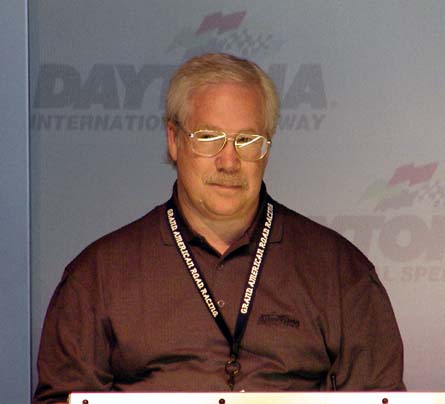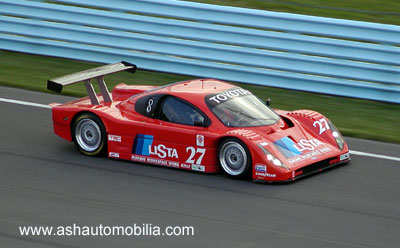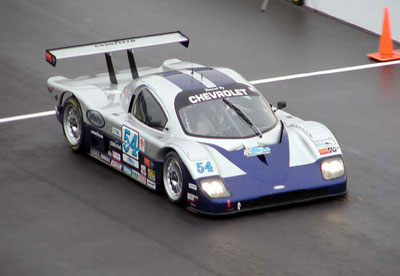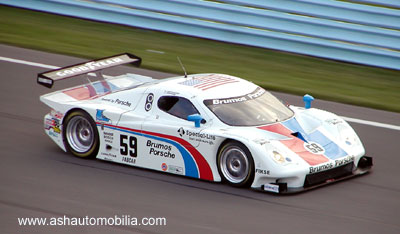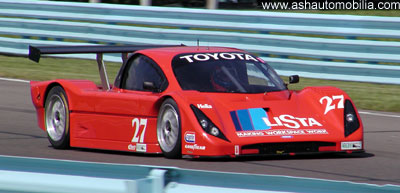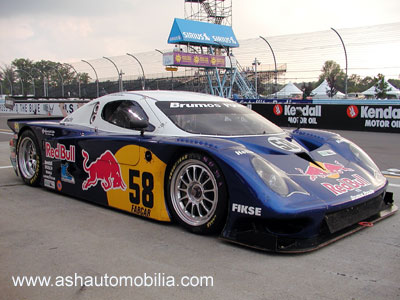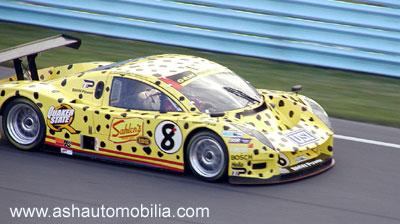Updated: 11/22/2013
Talking With Roger Edmondson – President of Grand-Am
© Andrew S. Hartwell
Over the lifetime of organized and “professional” sportscar racing in the
United States – 55 years if we can assume the year 1948 as the ‘date of birth’,
with the races in the streets at Watkins Glen and Elkhart Lake as the first
‘children’ – there have been many opportunities for fans to disagree and debate
changes in the sport. Sometimes the debate is spirited, sometimes good-natured,
and sometimes downright ugly. One can’t go to a sportscar website forum lately
without reading vehement arguments for or against Grand-Am or the American
Le Mans Series.
Welcome to what is starting out as sportscar racing’s “Ugly Era”.
One camp thinks the lack of ever-changing technological enhancements (season to season) in Grand-Am equates to an inferior product. Another camp feels the costs involved in running in the ALMS are simply too high. Still others think the new Daytona Prototypes are just not attractive enough. And yet another argument suggests manufacturer involvement in the ALMS will not strengthen it, but in fact, harm it, by prohibiting privateer participation. The list of objections and counterpoints seems to grow with each passing day.
A typical (mild) exchange taken from the Grand Am message board:
A snippet of an original post by "Judge" - "If Grand Am is to be the premier series in American sportscar racing, they might at least provide cars which can run faster and compete more interestingly than those which compete in Trans Am. While the series has been interesting to watch at times, Trans Am has never been considered the top of the mark in sportscar racing at home or abroad."
Replies:
"Toyoter" - "Right, and having all that extra horsepower hasn't helped Trans-Am much, has it? If it's down to having more horsepower or having the kind of close racing we've seen from the DPs this year, I'll take the close racing any day."
"Ray cer X" - "(Judge) don't watch them anymore and don't comment on them any more, look at the Grand-Am Rolex Series as pebble skipping or something, you know, something that you would never watch or be interested in watching."
"Judge" - "Beyond all of this, I stand by my point. The DP's do not, in my opinion, carry impressive speed or maneuver in dynamic fashion. My view is that they are too slow to create excitement."
"Gofigure" - "Kudos from here JUDGE for your opinions & observations. It's just too bad that this is now the umpteenth time that this subject has been raised here, without effect."
You get the idea. The introduction of the Grand-Am concept has poured an enormous amount of fuel onto a fire that was just awaiting combustion. And the results have been explosive to say the least. Lines have been drawn and anyone crossing those lines, or anyone who even suggests straddling those lines, soon finds themselves with singed skin.
Reading some of the comments has, frankly, not been a fun way to spend time. What sort of change could have ever initiated such vitriolic dialogue you ask? It seems the answer is the Grand-Am and their vision for sportscar racing's future in North America.
We decided to get in touch with the one man who perhaps most personifies Grand-Am to the general public, it’s President, Roger Edmondson. We spent a good part of one evening asking questions that we think the "ugly debaters" want answered. Frankly, we didn’t know if we would get answers at all, or if we did, whether they would serve to fan the flames or extinguish them.
When you read on, you may think the answers will do both.
If you are one of the keyboard-killers who has often positioned yourself squarely in the center of this controversy, we suggest that you step away from your keyboard for a few minutes – make that a half hour - and listen to what we asked and what we were told. You might be surprised. Then again, you might feel as if you have been given more ammunition for 'your side'. One thing is certain, you will know more than you did before you read this. You might not like or agree with everything you are about to read, or you may be in complete agreement, but that is not the point. This isn’t a forum open for debate. This is an interview. So read on.
You can always fire up the keyboard when you are finished reading.
Roger Edmondson is the President of the Grand American Road Racing Association. He was lured away from retiring to Las Vegas after a period in which he led a motorcycle racing organization. At the urging of an old friend, he went to Daytona and became an integral part of the formation of the Grand-Am.
He tells us how he came to be the head of this new business, this ‘grand experiment’.
“I was in Las Vegas, in the process of buying a house – after having sold my motorcycle sanctioning body - when I got a call from Jim France. Without his help 20 some odd years ago I could not have started the motorcycle thing. In 1983 I came to him with an idea for a motorcycle racing organization. I felt it needed to have a Daytona component and he agreed with me. For years we had the largest amateur road racing organization in the world. So we had a background.
“He came to me and said there were several investors who were interested in starting a new organization and would I mind talking to them about possibly running it. I flew out to Daytona and met Bob Snodgrass, George Silverman, Rob Dyson, Skip Barber, George Pyne, Brian France and Jim France, and several others. From that meeting a decision was made to pursue the concept of forming the Grand-Am association. At that time, when I flew back to Las Vegas to back out of the contract we had entered into on our new house, I told my wife I wasn’t sure if we were going to start a sanctioning body to hold a whole series of races, or if we were going to simply go to Daytona and try to make the most we could out of the Daytona 200 motorcycle race and the 24 hours. We cranked up the motor home and drove back to Florida to start round two of the talks."
We asked Edmondson about the reasons behind forming a new sanctioning body. What was it that the 'founding fathers' envisioned for this new business they were starting.
“The original idea behind Grand-Am was to do what the USRRC was formed to do but appeared unable to do. That is to eliminate the peaks and valleys that have gone on in this sport since 1948. I have told the story many times that NASCAR and sportscar racing started at about the same time in the United States and the success of one and the failure of the other – in terms of commercial acceptance – is quite obvious to see.
“In many cases, that was due to the fact that NASCAR was tightly controlled and road racing wasn’t. It was allowed to go with whatever trend or manufacturer or voice, or whatever constituents made the most noise. We had a plan from the very beginning to try and put road racing on a more even keel. And we started by focusing on only the North American marketplace.
“That made it simple for us to decide that the French rules weren’t going to cut it. I have great respect for the 24 hours of Le Mans and it’s tradition and history. We have no quarrel with those rules for what they are, a set of rules to draw from the entire world’s population to run one race – for 48 cars – once a year. We did not believe, and we still do not believe they were the best foundation for a regular, thriving road race series, which we believe this country needed.
“We felt there were 300 million people out there who would be interested in this kind of series, one tailored for this marketplace. We felt there was a need."
We asked what it was about the rules specifically that Grand-Am found so unmarketable.
“We didn’t have a particular issue within the rules. I wouldn’t point to things like carbon brakes or diffusers or 18-inch wheels or that sort of thing. It was the history of those rules being capriciously changed based on the politics of the time and the politics of a marketplace that had nothing to do with the United States."
Would it be safe to say that the founders of the Grand-Am had a sense of their just being too many variables at play, too often?
“It was just totally out of control. It was very hard to imagine a series of American investors – I’m talking about promoters and others - getting real serious about a program in which they had absolutely no say and no control. And quite clearly having a handful of guys in France writing rules
for a race that was tailored to maximize their opportunities was not going to – except in rare circumstances – be ideal for a 10-15 race series in North America.
“So, there was nothing in particular that was offensive about any given rule, it was the general concept of needing to have your own destiny in your own hands.”
We next asked how the shape and form the Grand-Am has taken today – the way the cars look, the horsepower limitations, the choice of tire sizes and so on – came to be.
“The first decision was to make sure the technology that went into the cars was readily available, easily understood, easily replicated and affordable not only to purchase but to maintain and operate. The second thing we looked at was the phenomenon of cars flying with disastrous results. We wanted to make sure we minimized that likelihood. That manifested itself in things like the overhang front and back and other considerations better explained by the engineers.
“To get into other issues, for example the one that seems to be the most misunderstood and the one I hear the most about, there is the greenhouse effect. To start with, it was not our intention to create modern day vintage cars. In other words we weren’t interested in creating a new version of GTP. By the same token, I felt that we needed – if we were going to look for a broader audience - to have cars that would look sporty and be more in line with what the average North American could envision as a high performance car that he perhaps could identify with. Very much the same way the average NASCAR fan knows that the Chevrolet on the track is not the same as the one in the parking lot, but he still identifies with. And that is why I made the comment ‘more GT40 and less GTP’.
“The GT40 was a very attractive car, and still is. But it was clearly one that looked like it could hold two people. It had a more conventional greenhouse shape. That was the basis of my charge that I gave my technical team when they started the process. As part of that process they looked back over history at the size of the average American driver. We wanted to make sure that we had sufficient space within the car to take the helmet off a driver who had been rendered unconscious in an accident. We also wanted to assure ourselves that the likelihood of a driver hitting his head on any of the roll cage bars was near impossible, if you can call anything impossible.”
We next wondered if, now that several different ‘attractive’ cars of varying design have been built, has that concern for safety negated the stated goal to get cars on the track that fans can relate to?
“I don’t think so. I think that the people who were looking for us to make new GTP cars were disappointed in the way these cars look. But most people who have seen them in person have enjoyed the racing and they are no longer complaining about the greenhouse. And I haven’t had one driver come up to me after driving the cars and complain that there was too much space or that he wasn’t going to hit his head on anything.
“I think that the people who have decided to get on board with us have accepted why we did it and they are in full accord with the decision.”
Skip Barber was one of the few people who were there at the start of the formation of the Grand-Am who was not affiliated with NASCAR or employed by the International Speedway Corporation (ISC – owners of several race tracks including Daytona). Barber owns the Lime Rock Park facility and, being that track is so close to this writer’s heart, we asked if the Grand-Am would ever bring the DPs to northeastern Connecticut.
“I don’t know. We were there for the first two seasons of Grand-Am. We had a very awkward situation there. If we ran the entire field of cars that we had there at one time, we felt it was too many cars for the track with the closing speed differences between the GT cars and the SRP cars. And there was also very limited space on the pit road. But when we split the field we didn’t have enough SRP cars to make a decent show. We had 11 or 12 cars.
“In any rate, Skip and his staff decided to go in a different direction, and that was fine. Someday in the future we may have an opportunity to go back because, as our prototype field grows, the prospect of running prototype-only races certainly becomes more real, and that might be ideal at a place like Lime Rock.
“But we are not actively looking to expand our schedule at this point in time, because we are asking team owners to make a substantial investment in the infrastructure and the equipment necessary to field a prototype team. Every time you take them out of the box and go run them it costs a lot of money. We are hoping to stay with an 11 – 12 race schedule for a few more years and then go to up to 15 races per season."
One frequent topic raised in the forums is the issue of horsepower. Please tell us why the allowable engine size was limited to just 500 horsepower?
“Well, it isn’t limited to 500 exactly. What we did was we took an unrestricted engine from a Porsche GT3R that Porsche Motorsports North America had put together for us, and we ran it on the dyno at ProMotor and determined from that what its horsepower and torque characteristics were. It was somewhere around 500 horsepower. We used that engine as a baseline for every other engine that has been submitted.
“We chose that engine because we recognized Porsche’s historical background of always being there to provide equipment for road racing. Where other companies come and go based on their sales needs, Porsche has always provided equipment. We felt that needed to be recognized.
“Secondly, we wanted to return the driver and the team to the element and de-emphasize the car to some degree. By going to an engine that was fairly well developed, and one for which there was no great anticipation of finding a significant increase in horsepower over the next few years, that gave us a pretty stable performance platform to start with.
“There are a lot of benefits that come from being at that level. One is going to fairly small brakes and skinnier tires than were on the prior generation of cars. This makes our cars a little bit more interesting to drive. It opens up zones for passing that may not have otherwise existed. It also means the car slides both front and rear. Now, with limited horsepower, people are a little hesitant to put a bunch of downforce on these cars to stop the sliding because then they create all kinds of drag and they don’t have the horsepower to overcome it.
“We feel we have just the right amount of horsepower in these cars. It is enough to make them go 185 miles an hour at Daytona and yet not enough to overcome the drag that would cause them to be stuck to the road. It puts the driver back in the equation.”
With this apparent emphasis on the abilities of the drivers, we wondered if that suggested a marketing path Grand-Am planned to pursue, as does NASCAR.
“We use NASCAR as a model where it is appropriate.”
Does that include marketing?
“Well, it does to some degree but, NASCAR marketing today is completely different than it was back when it started. Those early years then for that organization are comparable years for our organization now. We are still building a product. Today, NASCAR’s product is extremely well established and they don’t have to go out and sell anybody on the value of the product. People are calling them looking for ways to get involved.
“In our case it’s a little different. In terms of presentation of the product we are trying to build, one of the major differences - besides the obvious ones in equipment – would be that we have multi-driver participation. If we were building a Trans-Am series then it would be a closer parallel to a NASCAR event, where it is real easy to identify who is in the #3 car, for example. In our case the cast of characters changes sometimes from race to race.”
Does that mean you won’t place an emphasis on promoting the drivers?
“It just means that it is a different challenge.”
Then where will the emphasis lie?
“I think on teams and driver rivalries where it’s appropriate. But what we want to do first is try to build up the teams a little bit. Right now there has been a certain amount of fun watching the Red Bull team and the Brumos team – even though they are part of the same group – plus the Bell Motorsports team, all fighting it out. And there has been a kind of natural rivalry that some members of the media have picked up on, between David Donohue and Terry Borcheller.
“These are the sort of things that, as they develop, give the promoters something to talk about and something to give the public a little bit extra reason to get off their (chairs) and come out to the races.”
How do the Grand-Am organization and the individual promoter work together to promote a race?
“First off, it is a work in progress. Everybody talks about getting huge numbers (at competing race series) but I can tell you that I have inside information from people who are event promoters that in it’s heyday, a Sunday crowd of 15,000 was a good crowd for a Camel GT. RJ Reynolds was spending thousands of dollars to promote the series. Some of the numbers I have seen thrown about today, for some of these races, well I’d be real curious to see the kind of numbers that show up on the tax returns.
“But all that said, the promoters that are promoting Grand-Am races buy the product from us, much the way a wholesaler buys plumbing supplies from a plumbing supply manufacturer. And they retail the product one ticket at a time. “
Would you use the analogy that you are the entertainers and they own the theaters?
“That is very much the way the plan works. And so it is our job to create a program that they can resell and it is their job to make the theater all that it can be.”
Carrying that same analogy, if you go in to ‘play’ the Beacon Theater on Main Street in Rochester, New York, people who know who you will go to the show. But if you go to play in Rochester and the people there don’t know who you are, they might not go to the show. So, isn’t it reasonable to say that that area of responsibility lies with Grand-Am?
“The issue of national exposure does lie with Grand-Am. Right now our greatest vehicle is through our television partner, SPEED Channel. Right now there is not enough money in anybody’s coffers for us to have an impact through an advertising campaign that would make any difference in this country.”
Sorry, but we don’t understand that. What do you mean?
“If we spent a gazillion dollars on USA Today full page ads everyday for a month, 31 days from now there would still be some guy who wouldn’t know what we were about and who would never have heard of us. In other words there is no way to reach everybody in a traditional advertising campaign.
“We have to rely on first off, those who have an interest or those who seek us out, or stumble across us, OK? That comes through the television broadcasts on SPEED. The second area of outreach for us is that we have several events that are combo events. We will run with IRL, or CART or NASCAR.
“You know, I was in the stereo business for 20 years and one of our prime suppliers had a slogan; “Remember that our best prospect is our current customer.” There is no question that anybody who currently has an interest in motorsports is the person we want to reach because they are the most likely to be turned on by what we are doing.”
Coming back to the promoter – Grand-Am relationship for a moment, how many tickets does the promoter have to sell to make a profit?
“To make a profit, the average guy has to sell about 3,500 tickets. And you have to remember they have income from sponsorships, programs and concessions and so on. But 3,500 to 4,500 paying fans on a Sunday ought to be enough to give a promoter a fundamental, basic crowd. And once he has that crowd in place he has to use a different skill set than the one he used to get them to come out. That is he has to get them to want to come back and bring a friend.
“In many of our facilities right now, we are learning right along with them. 50% of our facilities are places that hold NASCAR events. And there, the emphasis is on taking care of that customer and making sure that the facility gives the people a weekend experience they are looking for.
“Many of our promoters have been around a long time but their business emphasis has been different. We are working with them, and learning with them. At the same time, the road race promoters on our other venues have had success with things like a CART event. This has allowed them the luxury of running a secondary event – such as the Grand-Am is right now. It is an interesting group.”
At what point should Grand-Am be satisfied with the fan count at the track?
“I think there is actually a point where having too many fans can be a negative. I for example spent too many years in motorcycles to now want to sit in the middle of a big crowd! But seriously, I understand the need for them but there is probably some point where the increasing numbers of spectators will actually act to keep some people from coming back. There is a point where it gets to be too much of a hassle. But I don’t think we are in danger of hitting that point during my tenure. I think it will be a long slow process.
“And I don’t think people realize this but, spectator increases in the hundreds are important. If your event has 500 more people than it did last year that is a very good sign. I know that this is going to sound ludicrous to those who believe in those bullshit numbers but, that is a fact.”
“We are not going to approximate the size of the NASCAR crowds. But that doesn’t mean that we are not successful. I can go to a high school football game with 500 people there and not feel I am underachieving because I am not part of a crowd of 50,000 at an NFL game. NASCAR has done the same thing in the United States that Formula 1 has done in the rest of the world. That is they have overwhelmed every other aspect of motorsports in this country.
“I am satisfied if we go back to Phoenix and there are more people there than there was last year. That’s progress. I don’t want to have progress because we are going to have a naked lady jump off a ladder into a vat of Jell-O, or some other crazy promotion to bring in the fans. If we have slow steady growth that means that people are liking what they see. They are enjoying themselves and they are marking it down on their calendar to come back again next year. When that happens, you reach a point of profitability that now gives the promoter an annuity. As long as he can keep the customers satisfied that is how he makes his money. You don’t invest in the stock market thinking you will make all your money in a week. You are in it for growth over the long term.
“And these are people who are in this as promoters because they see it as a business. Most of them aren’t really fans; they see this as inventory in which they invest to sell at a profit. That’s all it is. That is not glamorous, it’s not sexy, but that is what it is all about.”
Who do you see as the people that will be the fan base for Grand-Am? Who do you feel will be the ones to look at the product you are offering and say, “I’m interested, I want to get involved, I want to find about this’?
“I think by and large it is anybody who has any interest in motorsports. I have been misquoted out of context that I don’t care about the traditional sportscar fan. In fact it wasn’t a total misquote, it was just taken out of context. What I really said was we weren’t concerned about them, and our lack of concern comes from two areas. First, the type of racing the traditional sportscar fan has shown a preference for and interest in is still there. In other words there is nothing we are doing to destroy anything or take away anything from the interest that that fan base already has.
“Secondly, we are not concerned – and I don’t mean we don’t care about them – I mean we are not concerned in this regard: If our races are entertaining, they will come. And so we are not necessarily positioning ourselves to that market that has traditionally been proven to be relatively small. Instead we are trying to make a program that is easier to understand for a larger number of motorsports fans.”
Are you saying you are presenting a new product so you are looking for a new audience, one that won’t draw from the followers of other series?
“Let me put it this way, there is no reason why a person who enjoys an ALMS event would not enjoy a Grand-Am event. OK? If they like sportscar racing they ought to like what we are doing. OK? But, by the same token, there are many reasons why people who are casual fans of NASCAR or IRL or CART might not enjoy an ALMS event because of the complexity of it. It requires a certain commitment to understand the classes and the equipment and the nuances. We sportscar / road racing types consider ourselves in many ways to be superior – at least that is what people say on the message board – to NASCAR fans. Part of that is because we know the secret code and we understand all the nuances and special things about our sport. But to the average man in the streets, sometimes that sort of thing is a barrier to his getting involved rather than something that will bring him in.
“I know that, for many years when running the hi-fi store, I thought I was doing the right thing by quoting the specifications. Flutter, distortion and things like that. Finally one of my manufacturers said we could sell a lot more equipment if we recognized that the customer just wants music. They don’t want to come in and feel like their fly is open. And that is what we were doing to them. It was the way I felt when I went into computer stores for the first time!”
Earlier you said you didn’t see Grand-Am as taking anything away from the other series. By offering an alternative product, aren’t you actually siphoning off potential combatants, entrants, and team owners from the other series? Aren’t you diluting the traditional sportscar scene?
“That makes sense only if you assume it is a zero sum gain. If you assume that certain people have been designated by GOD to have to participate in sportscar racing, then we would certainly be siphoning (them) off. Based on the assumption that they originally belonged over there – which I believe to be an incorrect assumption. For example, we have a 12 race schedule and add that to whatever the number for ALMS and the assumption would be then that, if we didn’t exist there would still be 23 or 24 races – whatever the number – put on by as many promoters, and that all of these people and teams would be participating. That is a faulty assumption. This thing has never been that healthy.
“We have a product that appeals to a certain number of people and they have a product that appeals to a certain number of people. So be it. But you see their success or failure has little to do, in fact I would almost say nothing to do, with ours. Except in this regard, every fan they draw to the sport is a potential fan for us, and a potential set of eyeballs for our sponsors. And I believe the same to be true in the other direction.
“We are really not about destroying or taking away anything. We are all about building stuff.”
Along those lines, do you ever see a point in time where all the major sanctioning bodies will be on the same page?
“No.”
Is it just too political?
“No I don’t know that it is political. I don’t think that you could convince the people at the ACO that the best 24 Hours of Le Mans they could organize would be based upon rules that worked perfectly at Phoenix, Arizona on a Saturday night. And work just as well at Barber Motorsports Park a few weeks later. I don’t think that is what they are all about. I think they are about putting the 48 highest technology cars that the world can build on a racetrack once a year. They have no reason to align themselves with us.
“When you look at it that way, maybe it makes it easier to understand our view? They have their own set of needs and it is not logical to assume this one-world thing that people want to look at is possible. It is a lot different over there.
“I spent so many years in motorcycle racing and I was astounded at how we could have an event that we thought was the center of the universe and go across town and find out that nobody cares. This is true because, in this country, only a small percentage of people really care about motorcycles, as far as having a major impact on the marketplace. But in Europe, motorcycles are a major part of the transportation system and as a result, the same guys who are ignored here are just knockdown heroes over there.
“It is like those liberals who tried to convince us several years ago that there is no difference between men and women. I’m sorry but I discovered there is a difference. So to say there is no difference between us and Europe – or elsewhere – is to deny reality.”
Some would say that what the Grand-Am has really created is a spec series because the cars are working within such stringent parameters. What do you consider the product to be and if you were to say it is a spec series but at a higher level, how do you avoid being what spec series have traditionally been, the opening act for the primary performers? How can you take this, and make it the most appealing part of the weekend when series like Star Mazda and Barber Dodge and others are sometimes viewed as the race you have to get out of the way before the main event?
“First off, this is not a spec series. The product is competition. The product is racing. It is two human beings in an arena and competing head to head. Except that in our case we hope to have 30, 40 or 50 human beings.”
What would you consider a successful plateau number to be?
“I already have a success plateau on the prototypes. I predicted 10 by the end of the year and we will have ten by the end of the year. Our goal now is to have somewhere between 14 and 16 for the Rolex next year. I believe we will hit that and I’m hoping to have 20 by the end of next season. The reality is, as long as I have one more guy looking for a car than I have cars to offer than I have exactly what I need.
“Right now we have a group of constructors that we have frozen, to make sure they can do an adequate business and an adequate job of supporting the teams at the track. There are tight regulations. For example, besides saying how long the cars can be we have also said they can’t be shorter than a certain length. We have given people a box to build a car in. As a result they did not all come out looking alike. Everybody thought they were going to be identical. What we have specified, and what we have made the same is the stuff nobody cares about.
“Nobody cares about the brand of axles or uprights you have in your car. When Dallara would hand make a set, and Lola would hand make a set, and Ferrari would hand make a set they would all be different sizes and nothing would fit anything else. As a result the prices for parts would be astronomical and the burden on the team would be tremendous, as they had to carry their own parts with them in case they needed them. In other words, the whole infrastructure of stuff that did not have anything to do with what the fans saw or enjoyed was just completely out of control.
“Those are the things we specified, the things that really don’t matter to people who are watching these cars or driving these cars, but do matter to the people who own the cars and are paying the bills.”
Can a sportscar team - running in either the Grand-Am or the ALMS - expect to earn a profit from their racing efforts?
“It is so sensitive today to say anything about another series but I would like to just make an example. In an environment where the factories are allowed be run unfettered, when they can bring their best to the battle, there is no way a privateer is ever going to be able to earn enough to cover the expenses. And that is the environment we have today. As long as that is out there, there is always going to be the extreme haves and the rest will all be have-nots.
“And those factory teams are not there to make money. That is not the purpose of the exercise. It is just something their board decided to do to sell this year’s model cars. And once those cars are sold they will decide if they need to do that again the next year. That is the engine that drives the whole train unfortunately.
“In NASCAR it is altogether different. Everybody in that series is a professional who is in the game to make a living. They are put together to fly the sponsor’s flag and make a living. Budgets are set, the money is found and it is run like a business. I don't expect that to happen in sports car racing anytime soon."
Isn’t that what Grand-Am is trying to do?
“We are trying to minimize the danger. The facts are that you have to plan on an annual budget of at least a million dollars to run one car, once you factor in the price of the car and creating the infrastructure needed to support the team throughout the season. Our total purse - the total - is just around 3 million dollars! That is where the state of the art is. Anything lower than that and the promoters would be assured of huge losses and they wouldn’t hold events.
“NASCAR is huge because it is an incredible advertising medium. It is just like your local newspaper. The newspaper isn’t printed everyday because someone felt compelled to bring us the news. It is printed because somebody paid for the ads. That is all that newspaper exists for. It does not exist to inform. It does not exist to change my mind about being a conservative or a liberal. It exists to sell me shoes or tires or whatever items. That is the only reason that paper is brought to my house everyday.”
What do you say to the sportscar purists who appreciate the technological advances that come from the cars like Bentley, Audi and Lola? People who say that this is the way it has been and this is the way it should always be. What do you say to them?
“I say that I disagree. The purist is entitled to that and I don’t get angry because he feels that way. That is one of the things that is so amazing to me, the fact that the world should be big enough for our view and their view, yet they seem angry at us. I’m not sure I understand because, once again I repeat myself, that type of racing still exists. And they can find it at ALMS or at Le Mans. Our racing is just different.
“It is kind of like me going to McDonalds and raising hell at the guy because I like Burger King better. That’s ridiculous. If you like Burger King better then go to Burger King, don’t go to McDonalds. And for those who don’t appreciate or understand what we are doing, we have no quarrel with them. And we don’t desire to have a quarrel with them. If they prefer always faster cars every year, if the most important thing to them is lap times or top speed that’s fine. We prefer margin of victory. We think that number is more important than those other numbers.
“That doesn’t mean either one of us is evil.”
Typically organizations are formed to make a profit. Even the hobbyist who starts out with a small business about what interests him or her realizes that you have to turn a profit and keep the business going. Looking at it strictly in terms of the Grand-Am as a business, where do you want this business to ‘grow to’?
“We are in fact a for-profit corporation. I’m charged to deliver a profit to the investors and that is how I intend to run this business. Making a profit means that we have to live within our means and limit what we spend just like everybody else in the real world. That means we don’t go out and buy all the trappings of success. We live within our means.
“One of the things I said early on about Grand-Am was that we were not going to hit the ground running. We were going to crawl and then learn to walk. And when we were walking, every time we put our foot down it was going to be on property that we owned. We are four and a half years old now and we are financially sound and we are stable as can be. And you even said in one of your recent articles that even people that didn’t like Grand-Am have come to the conclusion that we are going to be. Well I got to tell you that I knew that from day one because of the principals involved.
“The people who are involved with this do not quit. They have the staying power and they are committed to it.”
Where on the ‘bell curve’ is the point you want to reach? The place that tells you that you have reached the level of success you wanted to reach?
“There isn’t one. This is something I had to learn early on. Unlike building a house where the job is eventually done, this is something where there will always be something more to be done. There is always something we could do that would be more cost effective or create better competition. Grand-Am will always be a work in process.
“I have often said that the first picture we should put on our office walls should not be a sportscar, it should be a men at work sign. Um, make that “people” at work!
Any closing comments?
“We really see this approach as the next logical step for sportscar racing in North America. And as you found when you talked to people in the paddock at Watkins Glen, once people understand what we are doing, they are on the team. The best way I can put it is, they really ‘get it’. They then become the best evangelists we could possible have.”
“And I really do hope that nothing I have said will turn people off or be found offensive. I do not think of myself as a loud, pushy or arrogant kind of guy. Actually I’m hard to find at the races because I am probably a bit more reserved than I ought to be. But I am very gratified and comfortable with where we are headed. And I will always remember those who stood up to be pioneers with us. You know, this is going to be easy to be part of a couple of years from now when this is the thing to do. But right now there are people who have had to make a conscious decision that they weren’t going to be followers, they were going to be leaders. And those people will be remembered.”
“This is an idea whose time has come. Like it or not, it’s happening. In time, some will learn to like it. Some will never like it and GOD bless them. We have no quarrel with them.”
If you persevered and made it this far, why not grab a cup of coffee before you head for the keyboard? If what you have read here wasn’t enough to keep your fingers flying the caffeine will surely suffice.
Better yet, why not consider this plea for reason found in a message (posted by “pach233”) on the IMSA / ALMS message board.
“What I find funny is that Grand-Am fans and ALMS fans argue with each other instead of supporting the series. This and the other board have turned into this big war and it really gets tiring to read. What happened to sportscar fans that just want to see road racing? Can we just stop the stupid bickering? Nobody is making any progress. People can make arguments for both sides but in the end you’re still going to like what you liked before. Can we talk about racing instead of just arguing over which race series is better?”
